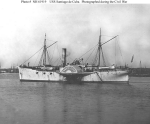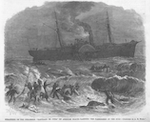Specifications:
Displacement 1,567 t.
Length 229'
Beam 38'
Depth 27'
Draft 16' 2"
Speed 14 kts
Complement 114
Armament
| Click On Image For Full Size Image |
Size | Image Description | Contributed By |
|
|---|---|---|---|---|
| Merchant Service |
||||
 |
65k | Watercolor by Erik Heyl, 1947 of the sidewheel steamer SS Santiago de Cuba painted for use in his book "Early American
Steamers", Volume I. Built at New York City in 1861, this steamer was commercially employed as SS Santiago de Cuba in 1861 and in 1865-1886. Between
1861 and 1865, she served as USS Santiago de Cuba. She was converted to a barge in 1886 and renamed Marion. US Naval History and Heritage Command Photo #: NH 63852. Courtesy of Erik Heyl. |
Robert Hurst | |
| USS Santiago de Cuba |
||||
 |
186k | "Merchant Steamers Converted into Gun-boats."
Engraving published in "Harper's Weekly", July-December 1861 volume. Depicts thirteen merchant steamships acquired by the U.S. Navy between April and August 1861 and subsequently converted into warships, plus the steamer Nashville (far left), which became a Confederate cruiser. US Navy ships as identified below the image bottom, are (from left to right: USS Alabama, USS Quaker City, USS Santiago de Cuba, (listed as "St. Jago de Cuba") USS Mount Vernon, USS Massachusetts, USS South Carolina, USS Florida, USS De Soto, USS Augusta, USS James Adger, USS Monticello, USS Bienville and USS R.R. Cuyler. US Naval History and Heritage Command photo # NH 59366. |
Robert Hurst | |
 |
84k | USS Santiago de Cuba at anchor, 1 January 1865, location unknown. US Naval History and Heritage Command photo # NH 61919. |
Robert Hurst | |
 098606105 |
84k | Steamship SS Santiago de Cuba The steamship Santiago de Cuba grounded on Abescom Beach, New Jersey on 22 May 1867. Sketched by A.R. Waud. Harper's Weekly Magazine, 8 June 1867. p. 355. | Robert Hurst | |
USS Santiago de Cuba
Dictionary of American Naval Fighting Ships (DANFS)
| Back To The Navsource Photo Archives Main Page | Back To The Old Navy" Steam and Sail Index |
| Comments, Suggestions, E-mail Webmaster. |
|
This page is created by Gary P. Priolo and maintained by Michael Junge |